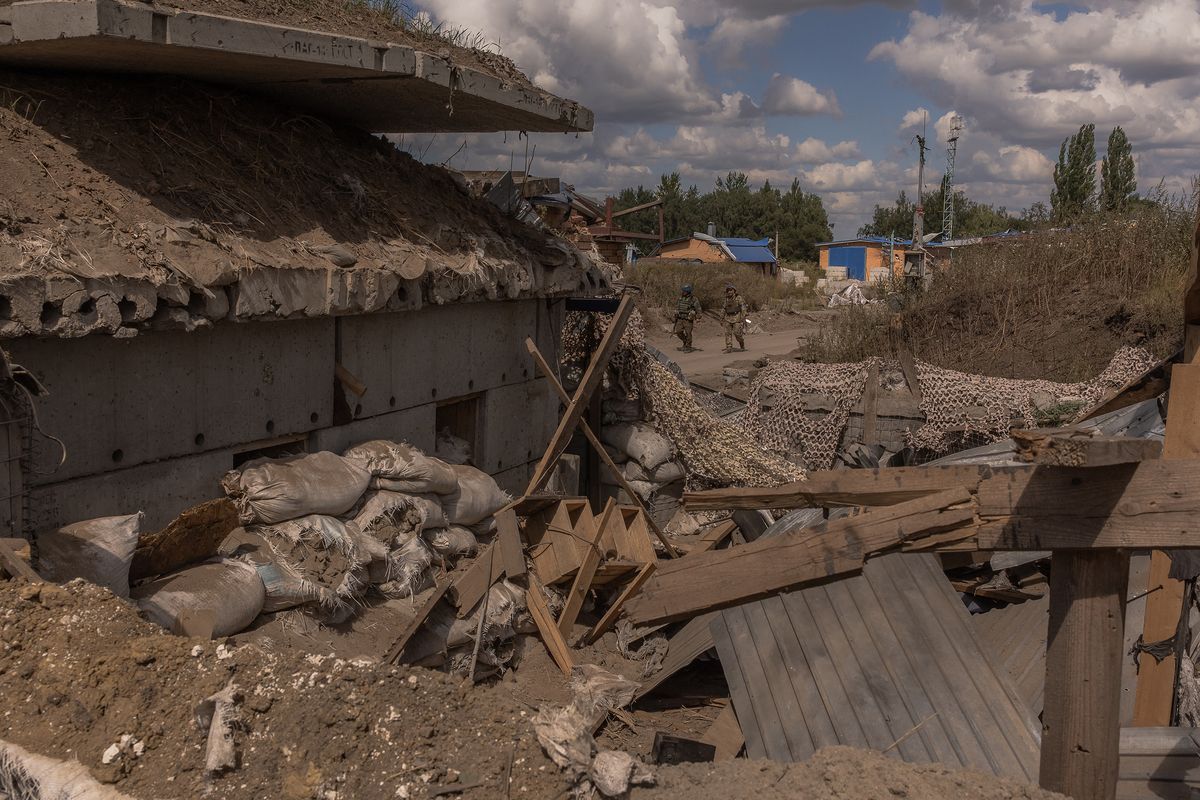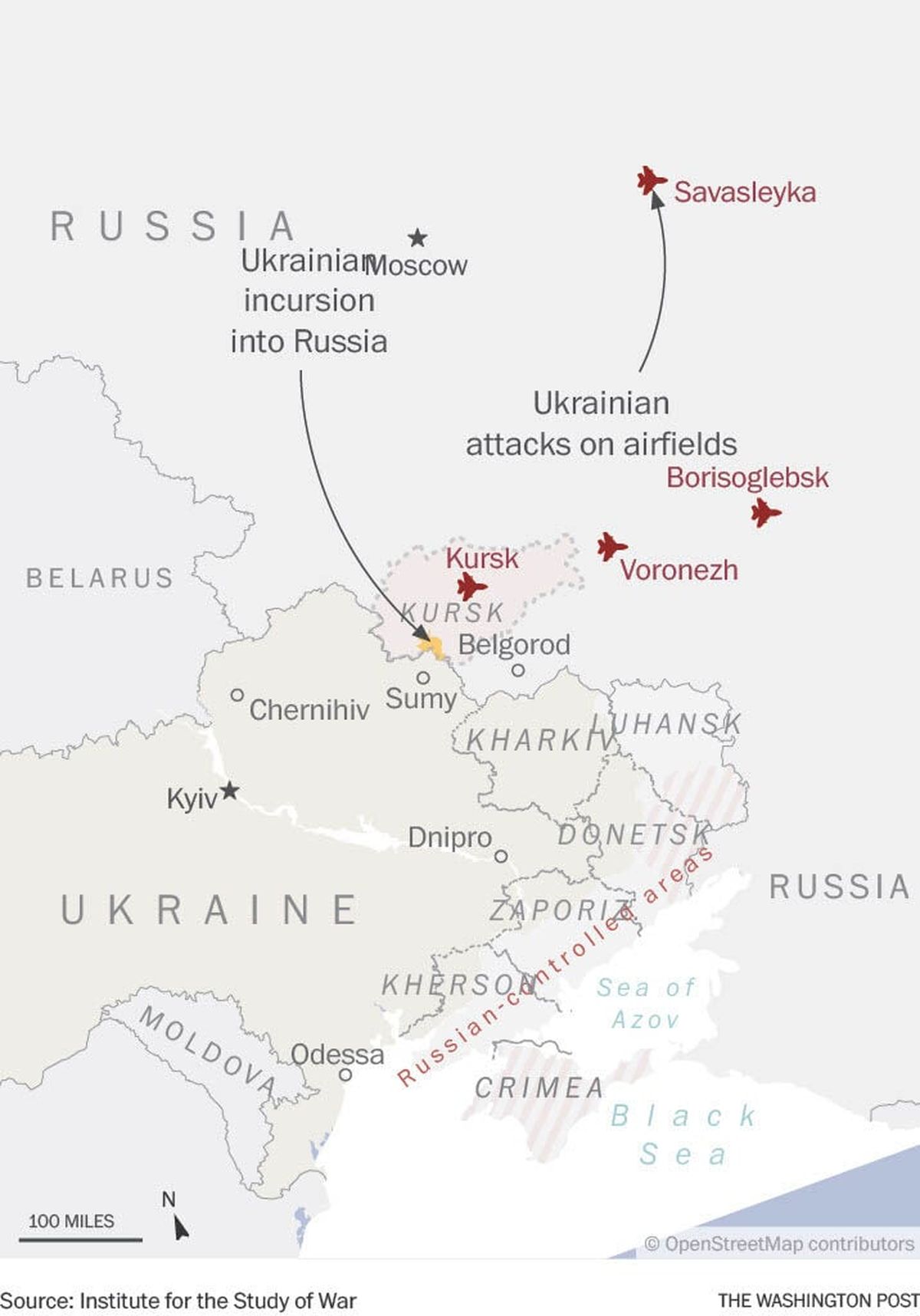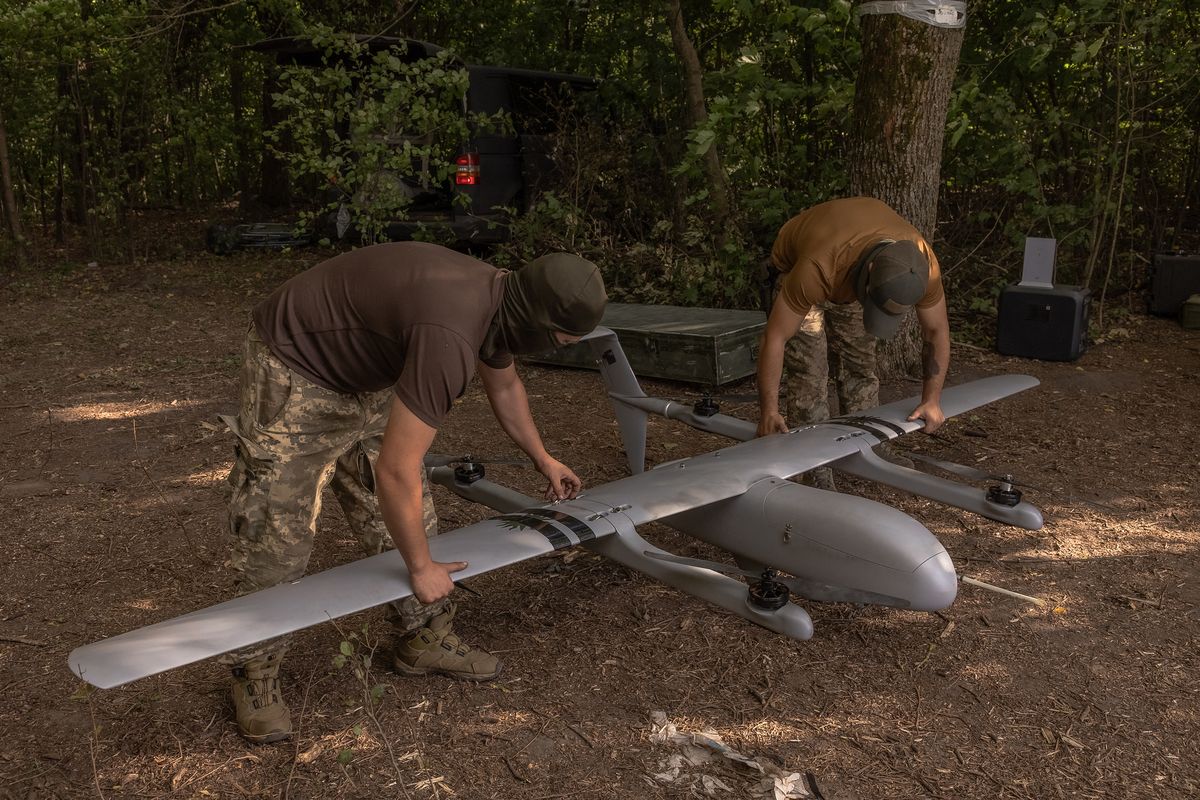Ukraine unleashes attacks on Russian airfields amid Kursk offensive
Above: Ukrainian military drone operators of the 22nd Mechanized Brigade assemble a Poseidon reconnaissance unmanned aerial vehicle at their position in the Sumy region near the border with Russia on Sunday amid the Russian invasion of Ukraine. Left: Ukraine’s incursion into the Kursk oblast in Russia is marked in yellow. Drone strikes conducted by Ukraine’s military on Wednesday targeted four airfields in Russian territory, including an air base in Savasleyka more than 400 miles from the countries’ shared border. (Roman Pilipey/AFP/GETTY IMAGES NORTH AMERICA/TNS)
Ukraine’s military mounted its largest drone attack on Russian airfields since the 2022 invasion, targeting four key sites deep inside Russian territory with dozens of drones overnight, as its forces continued their advance in the Kursk region of southern Russia.
After rushing reinforcements to Kursk and announcing a “counterterrorism” operation led by top commanders, Russian forces have failed to halt the nine-day incursion, despite daily announcements from military officials that Ukrainian forces had been stopped.
A Ukrainian intelligence official said that Kyiv attacked an air base in Savasleyka, more than 400 miles from the Ukrainian border, near Nizhny Novgorod. The base houses MiG-31 warplanes that launch Kinzhal missiles, among Russia’s most advanced weapons. About 10 explosions were reported at the base, according to Russian independent media, quoting locals.
Air raid alerts sound in Kyiv and across Ukraine – sometimes numerous times in one day – each time an MiG-31 takes off, as Kinzhal missiles have the capability of striking locations throughout the country.
“We are waiting for satellite photos with destroyed Russian fighters and warehouses,” the official said, speaking on the condition of anonymity because of the sensitivity of the subject.
Nizhny Novgorod governor Gleb Nikitin said on the social media site Telegram that Russian air defenses were working to suppress the attack and “minimize the consequences.” He said no casualties had been reported.
Video aired on Russian Telegram channels showed a distant fiery blast, followed by the sound of a large explosion. Another showed a drone flying overhead.
Ukraine has had success destroying Russian warplanes with drone attacks on airfields deep inside Russian territory, but is barred by its Western partners from using Western weapons, such as long-range missiles, to do so.
In addition to Savasleyka, the official said there were attacks on airfields in Voronezh, Borisoglebsk and Kursk, targeting bases for warplanes that fire the heavy glide bombs, locally known as KABs, that have devastated Ukrainian defenses over the past year.
The official described the airfield attacks as “a specially planned operation so that the enemy could not use these airfields for KAB strikes on the front line and Ukrainian cities.”
On Wednesday, Ukraine’s General Staff said in a post on X that its forces had shot down a Russian Su-34 fighter-bomber overnight. “The work to eliminate the occupiers, their equipment and weapons continues unceasingly,” the post said.
Russia’s Defense Ministry confirmed large-scale drone attacks in various parts of Russia and said 147 drones had been shot down.
Meanwhile, the Ukrainian attack on the Kursk region continues, with the commander of the military, Col. Gen. Oleksandr Syrsky, telling President Volodymyr Zelenskyy that his forces had advanced up to 1.2 miles in the Kursk region since Tuesday.
Zelenskyy appeared to signal that Kyiv’s forces may be there for some time, announcing the creation of military command posts “if necessary,” after a meeting to discuss securing the area and distributing humanitarian aid to Russian civilians.
Vyacheslav Gladkov, governor of Russia’s southern region of Belgorod, which is adjacent to the Kursk region, announced a state of emergency throughout the region because of Ukrainian attacks.
“The situation in our Belgorod region continues to be extremely difficult and tense,” he said in a Telegram address. “Daily shelling by the Ukrainian armed forces. Destroyed houses, wounded and killed civilians.”
He called for a federal state of emergency to step up assistance to the regions impacted by the Ukrainian attacks. The incursion has left tens of thousands of Russians feeling shocked and betrayed by the lack of a strong response from Moscow in the immediate aftermath of the Ukrainian assault. More than 130,000 people have been evacuated from Kursk and Belgorod since last week’s attack.
Ukraine’s surprise incursion last week, taking advantage of Russia’s thin defenses in the Kursk region, has boosted flagging Ukrainian morale and altered calculations in the slow, grinding war of attrition that has seen massive casualties on both sides. Ukraine’s attack has tested President Vladimir Putin and humiliated Russian military officials, with nationalist military bloggers calling for the dismissals of the commanders who were responsible.
But it has not altered the fundamental balance in a war in which Kyiv remains outmanned and outgunned by a far larger enemy, with Western military aid dribbling in too slowly to enable a Ukrainian victory.
On Tuesday, Lithuanian Defense Minister Laurynas Kasciunas told Zelenskyy in a meeting in Kyiv that Russia had begun to redeploy forces from the Kaliningrad region – a Russian area that lies west of Lithuania on the Baltic Sea – to Kursk.
Kasciunas said he told Lithuanians to “look at how the Ukrainians are fighting for you (and) because of their struggle, Russia needs to withdraw its troops from Kaliningrad.”
Ukrainian officials have not outlined their plans in Kursk, but as their forces push deeper into Russian territory, the risks will grow along with the potential for losses, according to military analysts.
“Ukraine protects itself and the lives of its people in border communities and takes active actions on Russian territory,” Zelenskyy said in a post on Telegram on Wednesday. “Our forces strictly comply with the requirements of international conventions and international humanitarian law.”
Syrsky reported that Ukrainian forces were in control of the town of Sudzha in Kursk, a claim contested Wednesday by Apti Alaudinov, the Russian commander of the Akhmat special forces in the region.
However, a Ukrainian television crew reporting from Sudzha filmed a team of Ukrainian soldiers removing the Russian flag from a building in the town. Traffic was flowing and there was no sign of a Russian presence in the area, according to the video.
The report said that Ukrainian forces were distributing food to Russians who were emerging from their basements after a week of airstrikes.
“We are advancing in the Kursk region, one to two kilometers in various areas since the beginning of the day,” Zelenskyy said in a separate post on X. “We have captured more than 100 Russian servicemen during this period. I am grateful to everyone involved; this will accelerate the return of our guys and girls home.”
On Tuesday, he said that hundreds of Russian soldiers had surrendered earlier.
The Kursk incursion has stretched Russian forces, preventing Moscow from deploying additional troops to Donetsk in eastern Ukraine, where Russia has steadily advanced in recent months while taking huge casualties.
Zelenskyy said he was “not forgetting our eastern front for a second. I have instructed the commander in chief to strengthen this direction using the equipment and supplies currently provided by our partners.”
The common thread in the Kursk attacks and the drone strikes on Russian airfields is Kyiv’s message to Moscow that Russian planes, bombs and missiles nestled inside its territory are not protected from Ukrainian attacks.
Ukrainian presidential adviser Mykhailo Podolyak said in a post on X on Wednesday that the war in Ukraine was viewed by many global observers as “a laboratory where the next big geopolitical conflict is being simulated.”
On Tuesday, President Joe Biden said that U.S. officials had been in “direct” and “constant” contact with their Ukrainian counterparts during the Kursk operations. “It’s creating a real dilemma for Putin,” Biden said.
- – -
Kostiantyn Khudov in Kyiv contributed to this report.
- – -
Graphic:
https://washingtonpost.com/documents/1b4bd28a-bd92-476f-ba2e-9d54b75551b0.pdf


